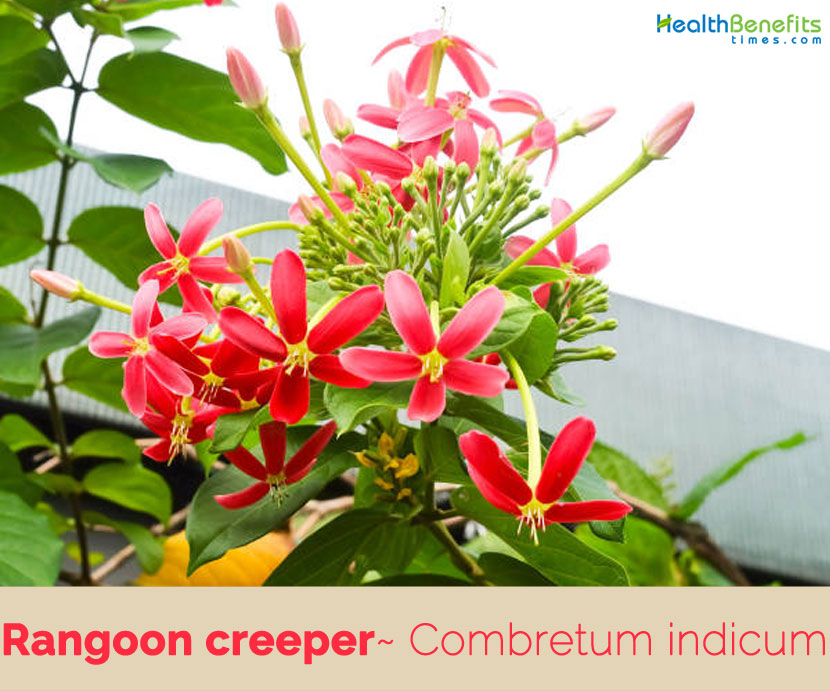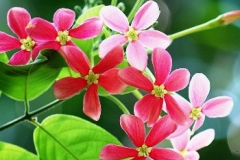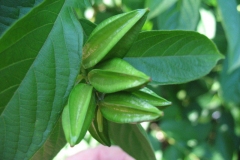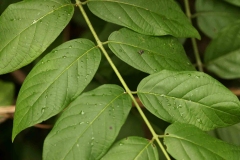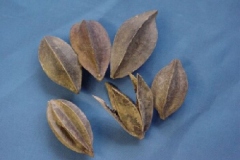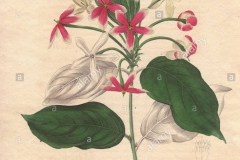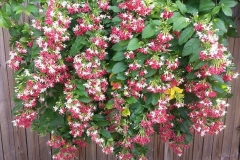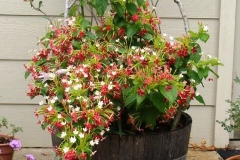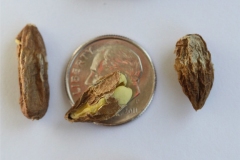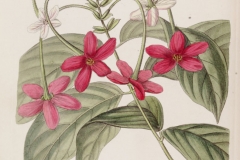Rangoon Creeper Facts
| Rangoon creeper Quick Facts | |
|---|---|
| Name: | Rangoon creeper |
| Scientific Name: | Combretum indicum |
| Origin | India, Southeast Asia and tropical Africa |
| Colors | Red turning to dark chestnut brown when ripe |
| Shapes | Fusiform dry capsules, narrowly ellipsoid, indehiscent, pubescent, 2.5-3.5 cm long and of about 1 cm of diameter |
| Taste | Tastes like almonds when mature |
| Health benefits | Beneficial for diarrhea, parasitic skin infections, rheumatism, toothache, abscesses, cough, diarrhea, headaches, nephritis, treats roundworm and pinworm |
| Name | Rangoon creeper |
|---|---|
| Scientific Name | Combretum indicum |
| Native | India, Southeast Asia (Kampuchea, Laos, Myanmar, Thailand,
Vietnam, Malaysia, Papua New Guinea and the Philippines) and tropical Africa (Benin, Ivory Coast, Ghana, Mali, Nigeria, Sierra Leone, Togo, Tanzania, Zaire and Angola) |
| Common Names | Burma creeper, Chinese honeysuckle, quisqualis, rangoon-creeper, Combretums, Rangoon jasmine, drunken sailor, red jasmine, Liane Vermifuge, Love and Innocence |
| Name in Other Languages | Arabic: Kaykwal hindiin (كيكوال هندي) Assamese: Madhavi lata (মাধৱী লতা), Rangan Bangladesh : Basantilata, Begunlata, Madhabilata, Modhumalati, Modhumanjuri, Ranganbel Bahasa: Ceguk Bengali: Madhumalti, Madhumanjari, Mādhurīlatā (মাধুরীলতা), Madhumanjari(মধুমংজরী) Burmese : Hta:Wèý-Mheing (ထားဝယ်မှိုင်း) Cambodia: Dong preah phnom, vor romiet nhi Chinese: Bing Gan Zi, Dong Jun Zi, Liu Qiu Zi, Se Gan Zi, Shan Yang Shi, Shih Chun Tze, Shi Jun Zi, Wu Leng Zi Cuba: Picuala, piscuala Czech : Hranoplod Indický Deutsch: Rangunschlinger Dutch: Quisqualis indica English: Burma creeper, Chinese honeysuckle, quisqualis, rangoon-creeper, Combretums, Rangoon jasmine, drunken sailor, red jasmine Finnish: Koukkuköynnös French: Quisqualis indica, Badamier, badamier sauvage, liane vermifuge Germany: Fadenröhre, Fadenröhre, Indische, indischer Sonderling, Rangun-Schlinger, Quisqualis Gujarati: Barmasi vel Hindi: Madhu Malti (मधुमालती), Madhumalti, Madhabilata, Rangoon-ki-bel, rangun, rangunumalli Indonesia : Ceguk, Cekluk Kacekluk, Kecukluk, Wedani, Kunji Rhabet, Rabet Dani, Rhabet Besi, Saradengan, Udani, Udani, Bidani Indonesia/Sumatra: udani Japanese : Shikunshi (シクンシ), Indo-shikunshi Javanese: Wedani Khmer : Dong Preah Phnom, Khua Hung Sa Mang Vor Romiet Nhi Korean : Saguncha Laotian : Dok Ung, Kheua hung, Sa Mang Malay: Pokok Akar Dani Malaysia: Akar Dani, Akar Cucur Atap, Akar Setanduk, Ara Dani, Akar Pontianak, Bunga akar dani, Redani, Selimpas, Setanduk Malayalam: Akar Dani, Udani yaśēādappū (യശോദപ്പൂ) Manipuri: Parijat (পারিজাত) Marathi: Vilayati Chambeli (Vilayati chambeli) Myanmar: Dawe-hmaing-nwe, mawk-nang-nang Nauru: Drunken sailor Nepali: Madhumaalatee phool (मधुमालती फूल) Nicaragua: Santa Cecilia Nigeria : Ọ̀gàn Fúnfún, Ọ̀gàn-Igbó Panama: Karate del humano Papua New Guinea: Womboy Philippines: Balitadham, bonor, kasunbal, niog-niogan, pinion, piñones, tagarau, tagulo, talolong, talulong, talulung, tanglong, tangelo, tangolon, tangelo, tartaraok, tartarau, taungon, totoraok, Babi-babe, balitadhan, kasumbal, niugniugan, niyog-niyogan, sagasi, sagisi, tagisi, tangalon, tortoraok Polish : Cudacznik Indyjski Portuguese : Arbusto-Milagroso Puerto Rico: Cocuisa, corazon de hombre, cuiscualis Russian: Kviskvalis indiyskiy (Квисквалис индийский) Spanish: Quiscual, Santa Cecilia, Quisqualis indica, cocuisa, corazon de hombre, cuiscualis Sweden: Druckne sjömannen Tagalog: Niyog-niyogan Tamil: Irangan Malli Telugu: Radha Manoharam (రాధా మనోహరం) Thailand: Cha mang, lep mue naang, thai-mong, Lĕbmụ̄xnāng (เล็บมือนาง) a-doning, cha mang, lep mue naang, macheemang, tha mang, thai-mong Tonga: Kaloni kakala Togo : Gargu Urdu: Ishq Pechaan (عسق پیچاں) Vietnam: Daay giun, quar giun, suwr quaan, Cha ro, Chúa sá nằng, Dây Giun, Dây quân tử Hoa Giun, Quả nấc, Sứ Quân Tử Yoruba: Ogan funfun, ogan igbo |
| Plant Growth Habit | Vigorous, fast-growing, evergreen, deciduous, sub-woody climber or scrambling shrub |
| Growing Climates | Rainforests, low woods, thickets, hedges, mountains, dry hillsides, riversides, roadsides, woodlands, disturbed habitats, rice fields, in secondary forests, along edges of primary forests, wasteland and railway tracks |
| Soil | Tolerate a range of soils from medium to heavy and prefers well-drained soils but can withstand cold spells. It has low tolerance for salinity and while it can tolerate partial shade, it prefers full sunlight |
| Plant Size | About 3–8 m |
| Stem | Cylindrical stems are green and softly hairy when young, becoming woody with age |
| Leaf | Opposite or subopposite, blades 6-17.5 cm long and 2.2-7 cm wide, elliptical, oblong, or lanceolate, chartaceous, the apex acuminate, the base rounded, the margins entire |
| Flower | Fragrant, bisexual, pentamerous and tubular. Calyx tube is yellow pilose with five deltoid lobes 1.5–2.5 mm long with acuminate apices. Petals 5 are obovate to oblanceolate, 8–16 mm long, with obtuse apices, white turning to pink or red |
| Fruit Shape & Size | Fusiform dry capsules, narrowly ellipsoid, indehiscent, pubescent, about 2.5-3.5 cm long and of about 1 cm of diameter |
| Fruit Color | Red turning to dark chestnut brown when ripe |
| Propagation | By seeds, stem cuttings, air layering and root suckers |
| Taste | Tastes like almonds when mature |
| Plant Parts Used | Fruit, seed, leaves |
Plant Description
Rangoon creeper is a vigorous, fast-growing, evergreen, deciduous, sub-woody climber or scrambling shrub that normally grows about 3–8 m tall with pubescent terete branches. The plant is found growing in rain forests, low woods, thickets, hedges, mountains, dry hillsides, riversides, roadsides, woodlands, disturbed habitats, rice fields, in secondary forests, along edges of primary forests, wasteland and railway tracks. In the Philippines and Papua New Guinea the species can be found growing along primary forest margins and in secondary forest and woodlands, alongside riverbanks, and is persisting and weedy around old settlements. In Australia it reportedly grows along creeks and on rocky foreshore. The plant is tolerate of a range of soils from medium to heavy and prefers well-drained soils but can withstand cold spells. It has low tolerance for salinity and while it can tolerate partial shade and prefers full sunlight. Cylindrical stems are green and softly hairy when young, becoming woody with age.
Leaves
Leaves are simple, opposite or sub opposite, oblong elliptic to elliptic or lanceolate, chartaceous, blades are 5–18 cm long and 3–7 cm wide, with acuminate tips, obtuse to rounded base sand entire margin, abaxially brown pilose and adaxially glabrous. Upper surface is glabrous, with a prominent mid vein and lower surface is ferruginous-tomentulose or puberulous, with prominent venation. Petioles are 5-12 mm long.
Flowers
Inflorescence is in lax terminal racemes, 10–15 cm long, with linear-filiform to ovate, brown pilose deciduous bracts. Flowers are fragrant, bisexual, pentamerous and tubular. Calyx tube is yellow pilose with five deltoid lobes 1.5–2.5 mm long with acuminate apices. Petals 5 are obovate to oblanceolate, 8–16 mm long, with obtuse apices, white turning to pink or red; stamens 10 in two rows, adherent, scarcely exserted, ovary inferior, style filiform and stigma knob shaped.
The flowers change in color with age and it is supposed that this is an approach to gather more pollinators. The flower is initially white and opens at dusk. This attracts hawk moths with long tongues for pollination. On the second day it turns pink and on the third it turns red attracting day flying bees and birds. The flower also changes from a horizontal orientation to a drooping pose. [
Fruit
Fertile flowers are followed by fusiform dry capsules, narrowly ellipsoid, indehiscent, pubescent, about 2.5-3.5 cm long and of about 1 cm of diameter, with 5 longitudinal, 1-2 mm broad, wings, containing only one pentagonal dark seed. Fruits are initially red turning to dark chestnut brown when ripe.
History
The plant is indigenous to India, Southeast Asia (Kampuchea, Laos, Myanmar, Thailand, Vietnam, Malaysia, Papua New Guinea and the Philippines) and tropical Africa (Benin, Ivory Coast, Ghana, Mali, Nigeria, Sierra Leone, Togo, Tanzania, Zaire and Angola). It is now widely cultivated as ornamental and naturalized in the tropics. The plant is cultivated in China and Taiwan and has naturalized in northern Queensland and the northern parts of the Northern Territory, in New Caledonia, Southeastern United States (i.e. Florida) and the Caribbean (e.g. Puerto Rico and the Virgin Islands).
Health Benefits of Rangoon Creeper
Apart from a beautiful flower with a wonderful aroma, Madhumalti Plant, or Rangoon Creeper is proven to be beneficial in various medical sectors. This creeper plant has many medicinal values in it and is used to treat many health problems. It’s every part serves some therapeutic benefits. Let us have a look at the Rangoon Creeper Plant benefits
Leaves
- Treats skin problems: Rangoon Creeper’s leaves are used for skin problems such as boils and ulcers in the form of juice. It works effectively to settle boils and abscesses.
- Remedy to treat headaches: It is also used for headache and applies on the forehead, which can work efficiently in reducing headaches.
- Remedy to treat Dysuria or painful urination: You can also make a tea by boiling the leaves which help to get relief from pain while urinating.
Seeds
- Banishes Intestinal worms and Parasites: Dried seeds of Rangoon Creeper are also beneficial. This works to treat intestinal worms and parasites.
Fruits
- Treats Diarrhea and Fever: The ripped and roasted fruits of Rangoon Creeper in case of diarrhea and Fever.
- Treats inflammation of kidneys: The fruits of the creeper are also helping us to reduce inflammation of kidneys or treat nephritis.
Traditional uses and benefits of Rangoon creeper
- The species is used as a tea for various illnesses in Panama, and the dried fruits, “shijunzi” are listed in the official Chinese pharmacopoeia.
- Herb is used in stopping diarrhea, treatment of parasitic skin infections, use for pain relief, and treatment of rheumatism.
- In Vietnam, the fruits are used for treatment of ascariasis and oxyuriasis in children and for treating infantile malnutrition due to intestinal parasitosis.
- Decoction of the fruit is used as gargle for toothache.
- Seeds are used as anthelminthic and leaf for healing of abscesses in Thailand.
- In the Philippines, the fruit is used as vermifuge and the plant as cure for cough.
- Seeds macerated in oil are applied to parasitic skin diseases in China, and seeds are also used as vermifuge.
- Seeds are given with honey as an electuary for the expulsion of entozoa in children in Moluccas and India.
- Ripe seeds are roasted and administered for diarrhea and fever.
- In Malaysia, the fruits and leaves are used as vermifuge and the roots as so in Java.
- Plant decoction is used for diarrhea in children.
- The Malays used the leaf juice as a lotion for boils and ulcers and the leaves are applied directly for headaches.
- Ripe seeds are sweet and if the ovary wall and seed coat are removed are pleasant to eat but there are cases of people becoming ill on eating only two or three.
- Fruits and the seeds are used in Nigeria, Ivory Coast and Gabon for their anthelmintic properties and to cure diarrhea.
- Decoction of the root, seed or fruit can be used as anti-helmintic to expel parasitic worms or for alleviating diarrhea.
- Leaves can be used to relieve pain caused by fever.
- Seeds from the pod are useful for treating roundworm and pinworm.
- It is toxic to the parasite and kills it in the digestive tract.
- The bitter half ripe fruits and seeds are widely known as being anthelmintic and are used as decoction, particularly to treat ascariasis.
- Seed of the dried ripe fruit is used to reduce vomiting, and roots in decoction are also taken as a vermifuge.
- Leaf juice or seeds, macerated in oil, and are applied externally to treat boils, ulcers, parasitic skin infections and fever.
- Various preparations of the plant are applied both externally and internally for pain relief.
- In the Indian Ocean islands a decoction of the leaves is used to bath children with eczema.
- In the Philippines the fruits are chewed as a remedy for coughs.
- Crushed fruits and seeds are externally applied to alleviate nephritis.
- In Vietnam a root decoction is taken to treat rheumatism.
- In Papua New Guinea plants are eaten daily by men and women as a method of birth control.
- Roasted ripe seed C. indicum were given to treat diarrhea and fever.
- Macerated seed in oil were applied for parasitic skin disease.
- Leaves decoction was prescribed to treat abdominal pain.
- Decoction of boiled leaves is used for dysuria.
- In India and the Moluccas, seeds are given with honey as electuary for the expulsion of entozoa in children.
- In Indo-China, seeds are used as anthelmintic and for rickets in children.
- In Amboina, compound decoction of leaves used for flatulent abdominal distention.
- Juice of leaves relieve flatulence.
Ayurvedic Health benefits of Rangoon creeper
- Kidney Disease: Include Rangoon creeper fruits in your daily diet. It helps to alleviate Kidney inflammation.
- Abscess: Apply the crushed leaves of Rangoon creeper externally.
- Headache: Finely chop some leaves and apply to the head to get relief.
- Fever: Take roasted fruit of Rangoon creeper to treat Fever.
- Diarrhea: Roast the ripe fruits of Rangoon creeper and taken internally.
- Spematorrhoea, Weakness: Take leaves and flower of Rangoon creeper. Wash to clean dirt and then grind to extract juice. Take this juice twice a day empty stomach.
- Leucorrhoea: For treating white discharge drink flowers and leaves juice of Rangoon creeper.
- Diabetes: Extract 4 ml juice of Rangoon creeper flower or juice of fresh leaves. Drink regularly twice a day. This juice can be added to bitter gourd juice.
- Digestive disorders: Rangoon creeper leaves juice can be drink to cure digestive disorders. Or chew few leaves of this vine few times a day.
- Cold, cough, coryza: Take Rangoon creeper flowers and leaves, tulsi leaves, clove in water and prepare decoction. Drink this decoction few times a day.
- Parasitic worms: Eat ten seeds of Rangoon creeper two hours before last meal to expel parasite form body. Children should take four seeds only.
- Dysuria or painful urination: Decoction of boiled Burma Creeper leaves is taken as tea to relieve pain while urinating.
Culinary Uses
- In Indonesia, young shoots of the species are eaten, either raw or steamed.
- Plant has edible fruit that tastes like almond, and the flowers are eaten in Thailand.
- In tropical Africa and parts of Southeast Asia, it is cultivated for production of the drug (fruits and seeds) and as a leafy vegetable.
- Although they have no flavor, flower can be mixed into salads to add color.
Other Facts
- The long, flexible stems are known to be used to make baskets, fish weir and fish traps in West Africa.
- In tropical Africa and Southeast Asia, the species is cultivated as a popular leafy vegetable, and for medicine.
- The plant is widely grown as a medicinal plant; as an ornamental over fences, pergolas and trellises; and as hedges in gardens and parks.
- The plant extract exhibited mild repellency against the female oriental fruit fly Dacus dorsalis.
- indica extract exhibited anti-coccidial effect against Eimeria tenella in chicken.
- The plant is regarded as an emerging environmental weed in Northern Queensland and the northern parts of the Northern Territory.
Precautions
- In large doses they cause hiccups, dizziness, vomiting, and pain in the abdomen, diarrhea and even unconsciousness.
- An allergic reaction can cause skin rashes with or without itching, painful swelling of ankles and increase body temperature.
- Avoid heavy consumption of Rangoon creeper herbs when pregnant and while breast feeding.
References:
https://www.cabi.org/isc/datasheet/46654
https://www.itis.gov/servlet/SingleRpt/SingleRpt?search_topic=TSN&search_value=895374#null
http://www.hear.org/pier/species/combretum_indicum.htm
https://plants.usda.gov/core/profile?symbol=QUIN10
https://en.wikipedia.org/wiki/Combretum_indicum
https://npgsweb.ars-grin.gov/gringlobal/taxonomydetail.aspx?id=412158
https://wikivisually.com/wiki/Combretum_indicum
http://www.theplantlist.org/tpl1.1/record/kew-2732680
http://www.flowersofindia.net/catalog/slides/Rangoon%20Creeper.html
http://www.efloraofgandhinagar.in/climbers/combretum-indicum
https://indiabiodiversity.org/species/show/282031
https://www.monaconatureencyclopedia.com/combretum-indicum-2/?lang=en
http://tropical.theferns.info/viewtropical.php?id=Combretum+indicum
https://commons.wikimedia.org/wiki/Category:Combretum_indicum
https://davesgarden.com/guides/pf/go/31530/#b


